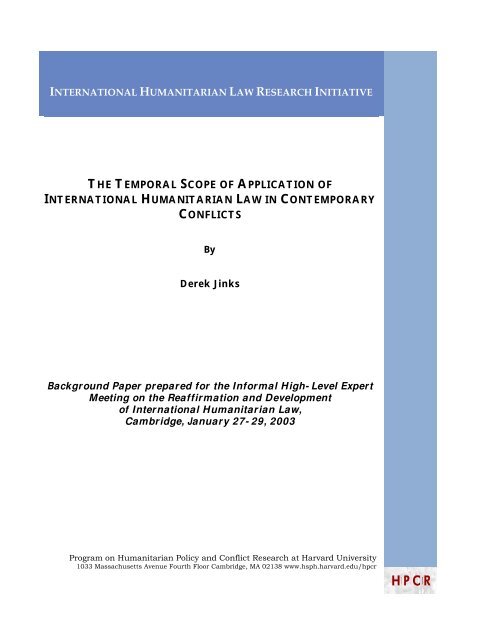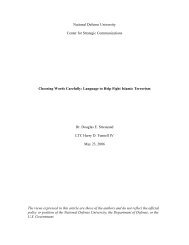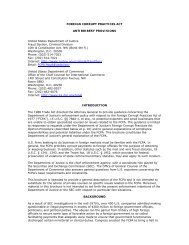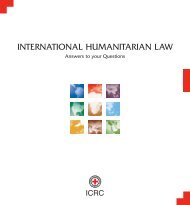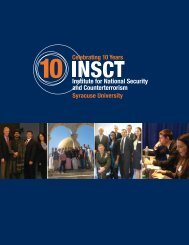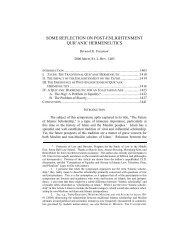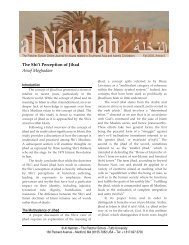the temporal scope of application of international humanitarian law ...
the temporal scope of application of international humanitarian law ...
the temporal scope of application of international humanitarian law ...
You also want an ePaper? Increase the reach of your titles
YUMPU automatically turns print PDFs into web optimized ePapers that Google loves.
INTERNATIONAL HUMANITARIAN LAW RESEARCH INITIATIVE<br />
THE TEMPORAL SCOPE OF APPLICATION OF<br />
INTERNATIONAL HUMANITARIAN LAW IN CONTEMPORARY<br />
CONFLICTS<br />
By<br />
Derek Jinks<br />
Background Paper prepared for <strong>the</strong> Informal High-Level Expert<br />
Meeting on <strong>the</strong> Reaffirmation and Development<br />
<strong>of</strong> International Humanitarian Law,<br />
Cambridge, January 27-29, 2003<br />
Program on Humanitarian Policy and Conflict Research at Harvard University<br />
1033 Massachusetts Avenue Fourth Floor Cambridge, MA 02138 www.hsph.harvard.edu/hpcr
HARVARD PROGRAM ON HUMANITARIAN POLICY AND CONFLICT RESEARCH<br />
Background paper<br />
THE TEMPORAL SCOPE OF APPLICATION OF INTERNATIONAL<br />
HUMANITARIAN LAW IN CONTEMPORARY CONFLICTS<br />
By Derek Jinks 1<br />
When does <strong>the</strong> <strong>application</strong> <strong>of</strong> <strong>international</strong> <strong>humanitarian</strong> <strong>law</strong> properly begin and<br />
end in modern conflicts Classical <strong>international</strong> <strong>law</strong> distinguished three types <strong>of</strong> armed<br />
conflict: (1) war; (2) civil war; and (3) armed hostilities short <strong>of</strong> war. The <strong>law</strong>s <strong>of</strong> war<br />
were applicable in time <strong>of</strong> war--from <strong>the</strong> declaration <strong>of</strong> war until <strong>the</strong> formal<br />
reestablishment <strong>of</strong> peace (for example, by <strong>the</strong> signing <strong>of</strong> a peace treaty). The <strong>law</strong>s <strong>of</strong> war<br />
were not applicable in civil wars--which were considered internal matters--unless a state<br />
formally recognized <strong>the</strong> insurgency as a belligerent. And, <strong>of</strong> course, <strong>the</strong> <strong>law</strong>s <strong>of</strong> war were<br />
not applicable as a formal matter in hostilities short <strong>of</strong> war. Prior to <strong>the</strong> drafting <strong>of</strong> <strong>the</strong><br />
Geneva Conventions in 1949, <strong>the</strong> applicability <strong>of</strong> <strong>the</strong> “<strong>law</strong> <strong>of</strong> war” was, <strong>the</strong>refore,<br />
delimited by formal acts <strong>of</strong> state such as a formal declaration <strong>of</strong> war or a formal<br />
recognition <strong>of</strong> belligerency. The Geneva Conventions substantially revised this<br />
formalistic, de jure approach--making contemporary <strong>international</strong> <strong>humanitarian</strong> <strong>law</strong><br />
applicable during armed hostilities that de facto constitute “armed conflicts.” In both<br />
<strong>international</strong> and non-<strong>international</strong> armed conflicts, <strong>the</strong> Geneva Conventions, in general,<br />
govern <strong>the</strong> conduct <strong>of</strong> hostilities for <strong>the</strong> duration <strong>of</strong> <strong>the</strong> “armed conflict.” This<br />
background note briefly outlines <strong>the</strong> regime established in <strong>the</strong> Geneva Conventions and<br />
summarizes several ambiguities in <strong>the</strong>se rules. Because <strong>the</strong> <strong>scope</strong> <strong>of</strong> <strong>application</strong> regimes<br />
differ sharply between <strong>international</strong> and non-<strong>international</strong> armed conflict, <strong>the</strong>se two types<br />
<strong>of</strong> conflict are analyzed separately.<br />
1 Assistant Pr<strong>of</strong>essor <strong>of</strong> Law, Saint Louis University School <strong>of</strong> Law<br />
1
I. THE TRADITIONAL APPROACH: THE “ARMED CONFLICT” THRESHOLD OF THE<br />
GENEVA CONVENTIONS<br />
In general, <strong>the</strong> Geneva Conventions apply from <strong>the</strong> initiation to <strong>the</strong> termination <strong>of</strong><br />
“armed conflict.” The “armed conflict” threshold requires some elaboration because: (1)<br />
<strong>the</strong> conditions triggering <strong>application</strong> <strong>of</strong> <strong>international</strong> <strong>humanitarian</strong> <strong>law</strong> differ for<br />
<strong>international</strong> and non-<strong>international</strong> armed conflicts; and (2) some “post-conflict”<br />
obligations are triggered prior to <strong>the</strong> close <strong>of</strong> military obligations.<br />
A. Beginning <strong>of</strong> Application: The Initiation <strong>of</strong> “Armed Conflict”<br />
1. International Armed Conflict<br />
The Geneva Conventions apply in full to “all cases <strong>of</strong> declared war or <strong>of</strong> any<br />
o<strong>the</strong>r armed conflict which may arise between two or more <strong>of</strong> <strong>the</strong> High Contracting<br />
Parties, even if <strong>the</strong> state <strong>of</strong> war is not recognized by one <strong>of</strong> <strong>the</strong>m,” or in “any cases <strong>of</strong><br />
partial or total occupation <strong>of</strong> <strong>the</strong> territory <strong>of</strong> a High Contracting Party.” 2 The applicability<br />
<strong>of</strong> <strong>international</strong> <strong>humanitarian</strong> <strong>law</strong> presents is clear in <strong>the</strong> case <strong>of</strong> declared wars between<br />
two or more states. Such conflicts clearly qualify as an <strong>international</strong> armed conflict to<br />
which <strong>the</strong> Geneva Conventions would apply in <strong>the</strong>ir entirety. Of course, such conflicts<br />
have also become rare. By its terms, Geneva <strong>law</strong> also applies to situations amounting to<br />
<strong>international</strong> “armed conflict.” Hostilities between states are, for <strong>the</strong> most part, governed<br />
by <strong>the</strong> <strong>law</strong>s <strong>of</strong> war irrespective <strong>of</strong> <strong>the</strong> intensity, duration, or scale <strong>of</strong> <strong>the</strong> conflict.<br />
According to <strong>the</strong> <strong>of</strong>ficial commentary <strong>of</strong> <strong>the</strong> International Committee <strong>of</strong> <strong>the</strong> Red Cross<br />
(ICRC), <strong>the</strong> conditions for an <strong>international</strong> war are satisfied whenever any difference<br />
arises leading to <strong>the</strong> use <strong>of</strong> armed force between <strong>the</strong> militaries <strong>of</strong> two states.<br />
2. Non-International Armed Conflict<br />
Common Article 3 provides that in “armed conflicts not <strong>of</strong> an <strong>international</strong><br />
character” each party to <strong>the</strong> conflict shall observe certain minimum standards. The <strong>law</strong>s<br />
<strong>of</strong> war, however, do not provide an authoritative definition <strong>of</strong> “armed conflict.”<br />
Substantial evidence suggests, in fact, that <strong>the</strong> drafters <strong>of</strong> <strong>the</strong> Geneva Conventions<br />
purposely avoided any rigid formulation that might limit <strong>the</strong> <strong>law</strong>’s field <strong>of</strong> <strong>application</strong>.<br />
There is, as yet, no settled definition <strong>of</strong> “armed conflict” in <strong>international</strong> <strong>law</strong>; and<br />
unguided case-by-case analysis has <strong>of</strong>ten produced unsatisfying results. These problems<br />
are most acute in <strong>the</strong> context <strong>of</strong> putative internal armed conflicts (or conflicts “not <strong>of</strong> an<br />
<strong>international</strong> character”) because internal unrest is commonplace and states resist <strong>the</strong><br />
<strong>application</strong> <strong>of</strong> <strong>international</strong> <strong>humanitarian</strong> <strong>law</strong> in domestic matters. Indeed, <strong>the</strong> coherence<br />
<strong>of</strong> <strong>the</strong> “armed conflict” concept turns on <strong>the</strong> viability <strong>of</strong> <strong>the</strong> distinction between internal<br />
disturbances or insurrections and internal armed conflicts–<strong>the</strong> former being governed by<br />
domestic <strong>law</strong> (as conditioned by <strong>international</strong> human rights <strong>law</strong>) and <strong>the</strong> latter governed<br />
by <strong>international</strong> <strong>humanitarian</strong> <strong>law</strong>.<br />
2 GC, Common Article 2. I will not address <strong>the</strong> conditions under which <strong>the</strong> “occupation” rules are<br />
applicable--this topic is beyond <strong>the</strong> <strong>scope</strong> <strong>of</strong> this paper.<br />
2
Despite <strong>the</strong> textual similarity between Common Articles 2 and 3, divergent<br />
patterns <strong>of</strong> state practice and important policy concerns necessitate reading <strong>the</strong> “armed<br />
conflict” requirement <strong>of</strong> Common Article 3 somewhat more stringently. Common Article<br />
2 purports to regulate only conflicts between two or more entities with <strong>international</strong> legal<br />
personality–namely, states and, perhaps, “recognized belligerents.” Common Article 3,<br />
on <strong>the</strong> o<strong>the</strong>r hand, purports to regulate conflicts between states and sub-state armed<br />
groups even if <strong>the</strong> conflict is confined to <strong>the</strong> territory <strong>of</strong> one state. Because Common<br />
Article 3 regulates internal matters, <strong>the</strong> conditions <strong>of</strong> its applicability should be carefully<br />
construed to extend only to matters <strong>of</strong> <strong>international</strong> concern.<br />
B. End <strong>of</strong> Application: The “General Close <strong>of</strong> Military Operations” or <strong>the</strong><br />
“Cessation <strong>of</strong> Active Hostilities”<br />
In both <strong>international</strong> and non-<strong>international</strong> armed conflicts, <strong>the</strong> Geneva<br />
Conventions, in general, govern <strong>the</strong> conduct <strong>of</strong> hostilities for <strong>the</strong> duration <strong>of</strong> <strong>the</strong> “armed<br />
conflict.” Under <strong>the</strong> Geneva Conventions, <strong>the</strong> general rule is that <strong>international</strong><br />
<strong>humanitarian</strong> <strong>law</strong> applies until <strong>the</strong> “general close <strong>of</strong> military operations.” There are,<br />
never<strong>the</strong>less, exceptions to this general rule. First, <strong>the</strong> obligation to repatriate persons<br />
protected under <strong>the</strong> Third (POWs) and Fourth (Civilians) Geneva Conventions is<br />
triggered by <strong>the</strong> “cessation <strong>of</strong> active hostilities.” Second, <strong>the</strong> obligations imposed upon<br />
occupying powers by <strong>the</strong> Civilians Convention extend beyond <strong>the</strong> “general close <strong>of</strong><br />
military operations.”<br />
The clearest method <strong>of</strong> ending an “armed conflict” is by means <strong>of</strong> a peace treaty.<br />
This method <strong>of</strong> terminating conflicts, however, is increasingly rare--particularly given <strong>the</strong><br />
sharp decline in formal declarations <strong>of</strong> war. Even in <strong>the</strong> absence <strong>of</strong> a peace treaty, <strong>the</strong>re<br />
may be a complete cessation <strong>of</strong> hostilities; and <strong>the</strong> de facto resumption <strong>of</strong> normal<br />
peaceful relations between <strong>the</strong> parties. Never<strong>the</strong>less, active hostilities may cease in a<br />
variety <strong>of</strong> ways--some temporary, some permanent--including an armistice, a cease-fire,<br />
or a truce. Given <strong>the</strong> de facto “armed conflict” regime <strong>of</strong> <strong>the</strong> Geneva Conventions, <strong>the</strong><br />
general applicability <strong>of</strong> <strong>international</strong> <strong>humanitarian</strong> <strong>law</strong> terminates if active hostilities<br />
cease and <strong>the</strong>re is no probability <strong>of</strong> a resumption <strong>of</strong> hostilities in <strong>the</strong> near future. Recall<br />
that <strong>the</strong> “armed conflict” persists until <strong>the</strong> “general close <strong>of</strong> hostilities”--even though<br />
some obligations (such as <strong>the</strong> duty to repatriate POWs) are activated by <strong>the</strong> “cessation <strong>of</strong><br />
active hostilities.” It is important to note that many commentators have suggested that <strong>the</strong><br />
“general close <strong>of</strong> military operations” standard is distinct from <strong>the</strong> “cessation <strong>of</strong> active<br />
hostilities” standard. The latter refers to <strong>the</strong> termination <strong>of</strong> hostilities--<strong>the</strong> silencing <strong>of</strong> <strong>the</strong><br />
guns--whereas <strong>the</strong> former refers to <strong>the</strong> complete cessation <strong>of</strong> all aggressive military<br />
maneuvers. On this reading, an “armed conflict” might persist beyond <strong>the</strong> “cessation <strong>of</strong><br />
active hostilities.“ And, because <strong>the</strong> obligation to repatriate is triggered by <strong>the</strong> “cessation<br />
<strong>of</strong> active hostilities,” it necessarily follows that, in some circumstances, <strong>the</strong>re might be a<br />
duty to repatriate before <strong>the</strong> “armed conflict” as such is terminated.<br />
II. CURRENT CHALLENGES: IDENTIFYING POTENTIAL AMBIGUITIES IN THE GENEVA<br />
CONVENTIONS<br />
3
Contemporary conflicts have substantially clarified ambiguities in <strong>the</strong> traditional<br />
approach. Several recent developments raise important questions regarding <strong>the</strong> <strong>temporal</strong><br />
<strong>scope</strong> <strong>of</strong> <strong>application</strong> <strong>of</strong> <strong>international</strong> <strong>humanitarian</strong> <strong>law</strong> including: <strong>the</strong> prevalence <strong>of</strong> non<strong>international</strong><br />
armed conflicts (as well as hostilities that skirt along <strong>the</strong> boundary between<br />
<strong>international</strong> and non-<strong>international</strong> conflicts); changes in military tactics, operations and<br />
participants; <strong>the</strong> existence <strong>of</strong> non-traditional conflicts with evolving and open-ended<br />
objectives; and <strong>the</strong> emergence <strong>of</strong> conflicts which foreclose <strong>the</strong> possibility <strong>of</strong> diplomatic<br />
solutions. In this section <strong>of</strong> <strong>the</strong> paper, I identify several arguable ambiguities in <strong>the</strong><br />
Geneva Conventions that merit sustained reflection.<br />
A. Non-Traditional Conflicts and <strong>the</strong> Threshold <strong>of</strong> Application for “Non-<br />
International Armed Conflict”<br />
Perhaps <strong>the</strong> most pressing (and most obvious) ambiguity is <strong>the</strong> threshold <strong>of</strong><br />
<strong>application</strong> in non-<strong>international</strong> armed conflicts. As previously discussed, <strong>the</strong> “armed<br />
conflict” threshold <strong>of</strong> Common Article 3 is, without question, ambiguous. Because <strong>of</strong> <strong>the</strong><br />
prevalence <strong>of</strong> non-<strong>international</strong> conflicts, <strong>the</strong> purposeful ambiguity <strong>of</strong> Common Article 3<br />
should be reevaluated. In addition, non-<strong>international</strong> armed conflicts interact with<br />
<strong>international</strong> conflicts in increasingly complex ways. For instance, <strong>the</strong> September 11<br />
terrorist attacks on <strong>the</strong> United States set in motion <strong>the</strong> events leading to <strong>the</strong> <strong>international</strong><br />
armed conflict between <strong>the</strong> U.S., U.K., and Afghanistan--which is unquestionably<br />
covered by <strong>the</strong> Geneva Conventions. Although that much is clear, <strong>the</strong> question remains<br />
whe<strong>the</strong>r <strong>international</strong> <strong>humanitarian</strong> <strong>law</strong> applies to <strong>the</strong> September 11 attacks <strong>the</strong>mselves.<br />
And even if <strong>the</strong> September 11 attacks confirmed <strong>the</strong> existence <strong>of</strong> a non-<strong>international</strong><br />
armed conflict between <strong>the</strong> U.S. and al Qaeda, it is unclear whe<strong>the</strong>r and when <strong>the</strong><br />
substantial number <strong>of</strong> pre-September 11 attacks on <strong>the</strong> U.S. triggered <strong>the</strong> <strong>application</strong> <strong>of</strong><br />
<strong>international</strong> <strong>humanitarian</strong> <strong>law</strong>. Moreover, opponents in <strong>the</strong>se conflicts <strong>of</strong>ten will not be<br />
traditional combatants, which will in turn delay <strong>the</strong> recognition <strong>of</strong> a state <strong>of</strong> armed<br />
conflict even if force is projected from abroad.<br />
Because non-state actors have acquired <strong>the</strong> capacity to project coordinated force<br />
globally, <strong>the</strong> threshold <strong>of</strong> <strong>application</strong> in non-<strong>international</strong> conflicts should be examined.<br />
Discussion <strong>of</strong> <strong>the</strong>se issues requires taking stock <strong>of</strong> developments in <strong>the</strong> regulation <strong>of</strong> non<strong>international</strong><br />
armed conflict that post-date Common Article 3. These subsequent legal<br />
developments have arguably clarified <strong>the</strong> definition <strong>of</strong> non-<strong>international</strong> “armed<br />
conflicts.” Three important developments merit scrutiny: Protocol II to <strong>the</strong> Geneva<br />
Conventions, <strong>the</strong> judgment <strong>of</strong> <strong>the</strong> ICTY Appeals Chamber in <strong>the</strong> Tadic case, and <strong>the</strong><br />
statute establishing an International Criminal Court (ICC). Each <strong>of</strong> <strong>the</strong>se developments<br />
arguably <strong>of</strong>fers a more rigid conception <strong>of</strong> “armed conflict;” and, as a consequence,<br />
narrows Common Article 3’s material field <strong>of</strong> <strong>application</strong>. The multiple interpretive<br />
controversies identified in this section suggest several additional ambiguities.<br />
1. Protocol II to <strong>the</strong> Geneva Conventions<br />
Protocol II to <strong>the</strong> Geneva Conventions, pertaining to internal armed conflict, arguably<br />
resolved much <strong>of</strong> <strong>the</strong> controversy surrounding <strong>the</strong> definition <strong>of</strong> armed conflict in<br />
4
Common Article 3. Because <strong>of</strong> clear deficiencies in <strong>the</strong> <strong>international</strong> legal machinery<br />
regulating internal armed conflict, <strong>the</strong> ICRC and many states party to <strong>the</strong> Geneva<br />
Conventions undertook efforts to “reaffirm and develop” <strong>the</strong> <strong>scope</strong> and substance <strong>of</strong><br />
<strong>humanitarian</strong> <strong>law</strong>. These efforts culminated in two additional protocols to <strong>the</strong> Geneva<br />
Conventions. Protocol I expanded <strong>the</strong> definition <strong>of</strong> <strong>international</strong> armed conflict to include<br />
internal “wars <strong>of</strong> national liberation;” and clarified many important substantive<br />
provisions <strong>of</strong> <strong>the</strong> Geneva Conventions. In an effort to “develop and supplement”<br />
Common Article 3, Protocol II expanded <strong>the</strong> rules applicable in internal armed conflicts.<br />
On its terms, Protocol II is applicable to armed conflicts between forces <strong>of</strong> a High<br />
Contracting Party and o<strong>the</strong>r armed forces that are “under responsible command, [and]<br />
exercise such control over a part <strong>of</strong> its territory as to enable <strong>the</strong>m to carry out sustained<br />
and concerted military operations and to implement this Protocol.” The <strong>scope</strong> <strong>of</strong> Protocol<br />
II is fur<strong>the</strong>r clarified in Article 1(2), which provides: “This Protocol shall not apply to<br />
situations <strong>of</strong> internal disturbances and tensions, such as riots, isolated and sporadic acts <strong>of</strong><br />
violence and o<strong>the</strong>r acts <strong>of</strong> a similar nature, as not being armed conflicts.” Because<br />
Protocol II purports, on its face, to supplement Common Article 3 “without modifying its<br />
existing conditions <strong>of</strong> <strong>application</strong>,” <strong>the</strong> rigidly defined field <strong>of</strong> <strong>application</strong> in <strong>the</strong> Protocol<br />
arguably clarifies as a formal matter <strong>the</strong> situations in which Common Article 3 applies. In<br />
short, Protocol II arguably provides a positive, concrete definition <strong>of</strong> “armed conflict not<br />
<strong>of</strong> an <strong>international</strong> character.”<br />
Although this view enjoys a surface plausibility, <strong>the</strong> best reading <strong>of</strong> Protocol II is that<br />
it has a much more narrow field <strong>of</strong> <strong>application</strong> than Common Article 3. This conclusion<br />
finds support in <strong>the</strong> text <strong>of</strong> <strong>the</strong> two provisions, <strong>the</strong> drafting history <strong>of</strong> Protocol II,<br />
subsequent state practice, and <strong>the</strong> consensus <strong>of</strong> commentators. As a result <strong>of</strong> <strong>the</strong> two<br />
Protocols, <strong>the</strong> Geneva Conventions now recognize and regulate four distinct categories <strong>of</strong><br />
armed conflict: inter-state armed conflict under Common Article 2; internal “wars <strong>of</strong><br />
national liberation” as defined in Protocol I; “civil wars” proper as defined in Protocol II;<br />
and “armed conflicts not <strong>of</strong> an <strong>international</strong> character” under Common Article 3.<br />
Common Article 3, <strong>the</strong>refore, establishes <strong>the</strong> lowest threshold <strong>of</strong> <strong>application</strong> for <strong>the</strong> <strong>law</strong>s<br />
<strong>of</strong> war.<br />
2. ICTY Judgment in Prosecutor v. Tadic (Appeal on Jurisdiction)<br />
Jurisprudence <strong>of</strong> <strong>the</strong> International Criminal Tribunal for <strong>the</strong> Former Yugoslavia<br />
(ICTY) has arguably clarified <strong>the</strong> definition <strong>of</strong> “armed conflict” in <strong>international</strong><br />
<strong>humanitarian</strong> <strong>law</strong>. Established to prosecute individuals for serious violations <strong>of</strong><br />
<strong>humanitarian</strong> <strong>law</strong>, <strong>the</strong> ICTY has subject matter jurisdiction over war crimes, crimes<br />
against humanity, and genocide. In Prosecutor v. Tadic, <strong>the</strong> tribunal’s first case, <strong>the</strong><br />
Appeals Chamber defined <strong>the</strong> contours <strong>of</strong> <strong>the</strong> “armed conflict” requirement within <strong>the</strong><br />
meaning <strong>of</strong> <strong>the</strong> Geneva Conventions. Specifically, <strong>the</strong> Appeals Chamber held that:<br />
[A]rmed conflict exists whenever <strong>the</strong>re is a resort to armed force between<br />
States or protracted armed violence between such groups within a State.<br />
International <strong>humanitarian</strong> <strong>law</strong> applies from <strong>the</strong> initiation <strong>of</strong> such conflicts<br />
5
and extends beyond <strong>the</strong> cessation <strong>of</strong> hostilities until a general conclusion<br />
<strong>of</strong> peace is reached; or, in <strong>the</strong> case <strong>of</strong> internal armed conflicts, a peaceful<br />
settlement is achieved. Until that moment, <strong>international</strong> <strong>humanitarian</strong> <strong>law</strong><br />
continues to apply in <strong>the</strong> whole territory <strong>of</strong> <strong>the</strong> warring States or, in <strong>the</strong><br />
case <strong>of</strong> internal conflicts, <strong>the</strong> whole territory under <strong>the</strong> control <strong>of</strong> a party,<br />
whe<strong>the</strong>r or not actual combat takes place <strong>the</strong>re. 3<br />
Two aspects <strong>of</strong> this definition arguably represent important contributions to <strong>the</strong><br />
definition <strong>of</strong> “armed conflict.” First, <strong>the</strong> definition arguably implies that an “armed<br />
conflict” exists only if <strong>the</strong> armed group exercises control over a portion <strong>of</strong> <strong>the</strong> state’s<br />
territory. Second, <strong>the</strong> definition arguably classifies internal hostilities as an “armed<br />
conflict” only if <strong>the</strong> armed violence is “protracted.” Both requirements would represent<br />
important restrictions on <strong>the</strong> conditions under which Common Article 3 applies.<br />
Although this definition has proven quite influential, a careful reading <strong>of</strong> <strong>the</strong> tribunal’s<br />
reasoning makes clear that it does not narrow <strong>the</strong> <strong>scope</strong> <strong>of</strong> Common Article 3’s<br />
<strong>application</strong>.<br />
First, <strong>the</strong> tribunal’s definition does not require that armed groups exercise control<br />
over territory within <strong>the</strong> state. The tribunal defines <strong>the</strong> circumstances in which<br />
<strong>international</strong> <strong>humanitarian</strong> <strong>law</strong> applies by carefully parsing its general material field <strong>of</strong><br />
<strong>application</strong> (all “armed conflicts”); territorial field <strong>of</strong> <strong>application</strong> (all territory affected);<br />
and <strong>temporal</strong> field <strong>of</strong> <strong>application</strong> (from <strong>the</strong> initiation to <strong>the</strong> cessation <strong>of</strong> hostilities). In<br />
defining <strong>the</strong> territorial field <strong>of</strong> <strong>application</strong> for internal armed conflicts, <strong>the</strong> tribunal only<br />
makes clear that <strong>humanitarian</strong> <strong>law</strong> applies (1) even in territory no longer under <strong>the</strong><br />
control <strong>of</strong> <strong>the</strong> state; and (2) throughout such territory.<br />
Second, <strong>the</strong> “protracted” armed violence requirement, properly understood, does not<br />
restrict <strong>the</strong> <strong>application</strong> <strong>of</strong> <strong>humanitarian</strong> <strong>law</strong> in any appreciable way. The nature <strong>of</strong> <strong>the</strong><br />
finding contemplated by <strong>the</strong> ICTY Appeals Chamber suggests that most instances <strong>of</strong><br />
internal strife would satisfy this requirement. Whe<strong>the</strong>r internal armed violence is<br />
“protracted” or not is assessed by reference to <strong>the</strong> entire period from <strong>the</strong> initiation to <strong>the</strong><br />
cessation <strong>of</strong> hostilities. Few, if any, putative internal armed conflicts would fail to satisfy<br />
this requirement so conceived. In addition, <strong>the</strong> <strong>law</strong>s <strong>of</strong> war apply to all acts committed in<br />
an armed conflict even if committed prior to <strong>the</strong> point at which <strong>the</strong> “protracted” threshold<br />
was crossed. That is, <strong>the</strong> “protracted” requirement does not immunize acts committed in<br />
<strong>the</strong> early stages <strong>of</strong> an internal armed conflict. In short, <strong>the</strong> “protracted” armed violence<br />
requirement is best understood as little more than a restatement <strong>of</strong> <strong>the</strong> general rule<br />
excluding “isolated and sporadic acts <strong>of</strong> violence” (disorganized and short-lived) from<br />
<strong>the</strong> <strong>scope</strong> <strong>of</strong> <strong>humanitarian</strong> <strong>law</strong>. Moreover, jurisprudence <strong>of</strong> <strong>the</strong> International Criminal<br />
Tribunal for Rwanda (ICTR) established that armed violence extending over only a few<br />
months satisfies <strong>the</strong> “protracted” requirement; and given <strong>the</strong> intensity <strong>of</strong> <strong>the</strong> violence, it<br />
constituted an “armed conflict” within <strong>the</strong> meaning <strong>of</strong> Common Article 3.<br />
3. International Criminal Court Statute<br />
3 Prosecutor v. Tadic, Appeal on Jurisdiction, Case IT-94-1-AR72 (Oct. 2, 1995), 35 I.L.M. 32,<br />
54, para. 70 (1996).<br />
6
The International Criminal Court (ICC) Statute also provides a more elaborate<br />
definition <strong>of</strong> internal “armed conflict” than Common Article 3. The ICC Statute identifies<br />
several acts as war crimes when committed in internal armed conflict. Specifically, <strong>the</strong><br />
Statute criminalizes “serious violations <strong>of</strong> Common Article 3” committed in “armed<br />
conflicts not <strong>of</strong> an <strong>international</strong> character and thus does not apply to situations <strong>of</strong> internal<br />
disturbances and tensions, such as riots, isolated and sporadic acts <strong>of</strong> violence or o<strong>the</strong>r<br />
acts <strong>of</strong> a similar nature.” 4 The Statute also criminalizes a much broader range <strong>of</strong> conduct<br />
characterized as “o<strong>the</strong>r serious violations <strong>of</strong> <strong>the</strong> <strong>law</strong>s and customs applicable in armed<br />
conflicts not <strong>of</strong> an <strong>international</strong> character, within <strong>the</strong> established framework <strong>of</strong><br />
<strong>international</strong> <strong>law</strong>.” 5 The criminal prohibitions identified in this ambitious provision apply<br />
in “armed conflicts not <strong>of</strong> an <strong>international</strong> character and thus does not apply to situations<br />
<strong>of</strong> internal disturbances and tensions, such as riots, isolated and sporadic acts <strong>of</strong> violence<br />
or o<strong>the</strong>r acts <strong>of</strong> a similar nature. It applies to armed conflicts that take place in <strong>the</strong><br />
territory <strong>of</strong> a State when <strong>the</strong>re is protracted armed violence between governmental<br />
authorities and organized armed groups or between such groups.” 6<br />
Several aspects <strong>of</strong> <strong>the</strong> ICC Statute’s approach should be emphasized. First, <strong>the</strong><br />
Statute adopts <strong>the</strong> general framework <strong>of</strong> <strong>the</strong> Geneva Conventions in that it <strong>of</strong>fers no<br />
affirmative definition <strong>of</strong> “armed conflict.” Second, <strong>the</strong> Statute codifies <strong>the</strong> ICRC<br />
Commentary’s view that internal “armed conflicts” within <strong>the</strong> meaning <strong>of</strong> Common<br />
Article 3 do not include “situations <strong>of</strong> internal disturbances and tensions, such as riots,<br />
isolated and sporadic acts <strong>of</strong> violence.” Third, <strong>the</strong> Statute adopts <strong>the</strong> ICTY’s “protracted<br />
armed violence” formulation but does not apply this requirement to Common Article 3<br />
conflicts. Moreover, <strong>the</strong> wording <strong>of</strong> Article 8(2)(f) itself suggests that it applies to one<br />
type <strong>of</strong> internal armed conflict⎯ armed conflicts where <strong>the</strong>re is protracted armed<br />
violence.<br />
Because <strong>the</strong>se legal developments have not clarified <strong>the</strong> material field <strong>of</strong><br />
<strong>application</strong> for Common Article 3, defining internal “armed conflict” requires grappling<br />
with <strong>the</strong> ambiguous regime established in <strong>the</strong> 1949 Geneva Conventions. Several<br />
ambiguities in <strong>the</strong> <strong>temporal</strong> <strong>scope</strong> <strong>of</strong> <strong>application</strong> are suggested by this analysis. First, if<br />
<strong>the</strong> “protracted” requirement is read into <strong>international</strong> <strong>humanitarian</strong> <strong>law</strong>--that is, only<br />
“protracted” internal hostilities constitute “armed conflicts” within <strong>the</strong> meaning <strong>of</strong> <strong>the</strong><br />
Geneva Conventions--<strong>the</strong>n <strong>the</strong> question arises whe<strong>the</strong>r <strong>international</strong> <strong>humanitarian</strong> <strong>law</strong><br />
covers acts committed prior to <strong>the</strong> point at which <strong>the</strong> hostilities became “protracted.”<br />
Does <strong>international</strong> <strong>humanitarian</strong> <strong>law</strong> apply from <strong>the</strong> initiation <strong>of</strong> hostilities or only from<br />
<strong>the</strong> point at which <strong>the</strong> conflict can fairly be characterized as “protracted” Second, if<br />
<strong>international</strong> <strong>humanitarian</strong> <strong>law</strong> applies only to internal conflicts that cross some threshold<br />
<strong>of</strong> intensity, <strong>the</strong>n this raises difficult questions about <strong>the</strong> point at which <strong>the</strong> applicability<br />
<strong>of</strong> this <strong>law</strong> terminates. More specifically, does <strong>the</strong> applicability <strong>of</strong> <strong>international</strong><br />
4 ICC Statute, art. 8 (2)(d).<br />
5 Id. art. 8 (2)(e). The chapeau <strong>of</strong> this section provides: “O<strong>the</strong>r serious violations <strong>of</strong> <strong>the</strong> <strong>law</strong>s and customs applicable in<br />
armed conflicts not <strong>of</strong> an <strong>international</strong> character, within <strong>the</strong> established framework <strong>of</strong> <strong>international</strong> <strong>law</strong>, namely, any <strong>of</strong><br />
<strong>the</strong> following acts . . .” Id.<br />
6 Id. art. 8(2)(f).<br />
7
<strong>humanitarian</strong> <strong>law</strong> terminate once <strong>the</strong> intensity <strong>of</strong> <strong>the</strong> fighting passes back below <strong>the</strong><br />
critical threshold Or, does it apply until <strong>the</strong> “general close <strong>of</strong> hostilities” or <strong>the</strong><br />
“cessation <strong>of</strong> active hostilities”<br />
B. Transnational, Non-International Armed Conflicts<br />
Contemporary non-<strong>international</strong> armed conflicts are <strong>of</strong>ten transnational in<br />
character. That is, <strong>the</strong> armed conflict spans <strong>the</strong> territories <strong>of</strong> several states even though<br />
<strong>the</strong> armed hostilities are not <strong>international</strong> (<strong>the</strong>re is only one state involved or all states<br />
involves are fighting on <strong>the</strong> same side). Again, <strong>the</strong> U.S.-led “war on terror” provides an<br />
instructive example. Al Qaeda is a transnational organization with operational cells in<br />
many countries. Any armed conflict between a state and such a group will likely take on<br />
a transnational character. The question is when <strong>the</strong> <strong>application</strong> <strong>of</strong> <strong>international</strong><br />
<strong>humanitarian</strong> <strong>law</strong> begins and ends in such conflicts.<br />
The Geneva Conventions did not envision this type <strong>of</strong> conflict. Indeed, one<br />
interpretation <strong>of</strong> Common Article 3 suggests that it applies only to armed conflicts within<br />
<strong>the</strong> territory <strong>of</strong> one state. On this view, <strong>the</strong> “not <strong>of</strong> an <strong>international</strong> character” limitation<br />
renders <strong>the</strong> provision inapplicable to all armed conflicts with <strong>international</strong> or<br />
transnational dimensions. Substantial evidence suggests that <strong>the</strong> drafters <strong>of</strong> <strong>the</strong> provision<br />
envisioned its <strong>application</strong> only in truly internal conflicts. In addition, <strong>the</strong> full text <strong>of</strong> <strong>the</strong><br />
provision <strong>of</strong>fers some support for this reading⎯<strong>the</strong> Article covers only cases <strong>of</strong> “armed<br />
conflict not <strong>of</strong> an <strong>international</strong> character, occurring in <strong>the</strong> territory <strong>of</strong> one <strong>of</strong> <strong>the</strong> High<br />
Contracting Parties.” Despite its textual plausibility, this reading <strong>of</strong> <strong>the</strong> provision is<br />
arguably problematic. First, this interpretation would create an inexplicable regulatory<br />
gap in <strong>the</strong> Geneva Conventions. On this reading, <strong>the</strong> Conventions would cover<br />
<strong>international</strong> armed conflicts proper and wholly internal armed conflicts, but would not<br />
cover armed conflicts between a state and a foreign-based (or transnational) armed group<br />
or an internal armed conflict that spills over an <strong>international</strong> border into <strong>the</strong> territory <strong>of</strong><br />
ano<strong>the</strong>r state. There is no principled (or pragmatic) rationale for this regulatory gap.<br />
Finally, this reading <strong>of</strong> <strong>the</strong> provision misconstrues <strong>the</strong> considerations that limit <strong>the</strong><br />
<strong>application</strong> <strong>of</strong> Common Article 3. Common Article 3 was revolutionary because it<br />
purported to regulate as a matter <strong>of</strong> <strong>international</strong> <strong>humanitarian</strong> <strong>law</strong> wholly internal<br />
matters. If <strong>the</strong> provision governs wholly internal conflicts, as <strong>the</strong> “one state”<br />
interpretation recognizes, <strong>the</strong>n <strong>the</strong> provision applies a fortiori to armed conflicts with<br />
<strong>international</strong> or transnational dimensions. The language <strong>of</strong> <strong>the</strong> provision limiting its<br />
<strong>application</strong> to <strong>the</strong> “territory <strong>of</strong> one <strong>of</strong> <strong>the</strong> High Contracting Parties” can be read ano<strong>the</strong>r<br />
way. Perhaps <strong>the</strong> wording <strong>of</strong> <strong>the</strong> provision simply makes clear that its <strong>application</strong> is<br />
predicated upon a jurisdictional nexus to a state party to <strong>the</strong> treaty.<br />
C. Internationalized Non-International Armed Conflict (and “Non-<br />
Internationalized” International Armed Conflicts)<br />
Contemporary conflicts <strong>of</strong>ten pass through stages at which <strong>the</strong>y are <strong>international</strong><br />
and stages at which <strong>the</strong>y are non-<strong>international</strong>. This difficulty arises because it is now<br />
common for a foreign state to intervene in a non-<strong>international</strong> armed conflict--<strong>of</strong>ten<br />
8
triggering a range <strong>of</strong> legal complexities. Where a foreign state intervenes on behalf <strong>of</strong> a<br />
“legitimate” government to assist in <strong>the</strong> repression <strong>of</strong> an insurgency, <strong>the</strong> armed conflict<br />
retains its “non-<strong>international</strong>” character. However, if <strong>the</strong> foreign state intervenes on<br />
behalf <strong>of</strong> a rebel movement in its fight against <strong>the</strong> government, this intervention would<br />
“<strong>international</strong>ize” <strong>the</strong> armed conflict. This type <strong>of</strong> conflict raises special problems<br />
regarding <strong>the</strong> <strong>temporal</strong> <strong>scope</strong> <strong>of</strong> <strong>application</strong> in <strong>the</strong> Geneva Conventions. And, perhaps<br />
more importantly, this type <strong>of</strong> conflict underscores <strong>the</strong> importance <strong>of</strong> defining more<br />
clearly <strong>the</strong> conditions under which specific rules apply. For example, consider <strong>the</strong><br />
hostilities in Afghanistan. The armed conflict in Afghanistan was probably a “non<strong>international</strong>”<br />
armed conflict between <strong>the</strong> Taliban and Nor<strong>the</strong>rn Alliance troops until U.S.<br />
forces intervened, at which point <strong>the</strong> conflict became <strong>international</strong>. When <strong>the</strong> Taliban<br />
ceded control <strong>of</strong> <strong>the</strong> government, <strong>the</strong> conflict may well have reverted to a non<strong>international</strong><br />
armed conflict, because U.S. forces were aligned with <strong>the</strong> newly-installed<br />
government <strong>of</strong> Afghanistan. Of course, <strong>the</strong> involvement <strong>of</strong> ano<strong>the</strong>r state (or <strong>the</strong><br />
resurgence <strong>of</strong> <strong>the</strong> Taliban) could re-<strong>international</strong>ize <strong>the</strong> conflict. The obvious difficulty<br />
here is that <strong>the</strong> applicable <strong>international</strong> <strong>humanitarian</strong> <strong>law</strong> is in a state <strong>of</strong> flux over <strong>the</strong><br />
course <strong>of</strong> <strong>the</strong> hostilities, and several ambiguities might be addressed. Does <strong>the</strong><br />
<strong>international</strong>ization <strong>of</strong> an internal conflict automatically trigger <strong>the</strong> <strong>application</strong> <strong>of</strong><br />
<strong>humanitarian</strong> <strong>law</strong> irrespective <strong>of</strong> whe<strong>the</strong>r <strong>the</strong> internal hostilities constituted an “armed<br />
conflict” Does <strong>the</strong> non-<strong>international</strong>ization <strong>of</strong> an <strong>international</strong> armed conflict (that is,<br />
<strong>the</strong> reversion <strong>of</strong> an <strong>international</strong> armed conflict to an internal armed conflict) constitute<br />
<strong>the</strong> “cessation <strong>of</strong> active hostilities” for <strong>the</strong> purposes <strong>of</strong> POW repatriation<br />
D. Non-Traditional Tactics in International Hostilities<br />
Finally, contemporary conflicts <strong>of</strong>ten involve <strong>the</strong> use <strong>of</strong> non-traditional war<br />
tactics that may not trigger <strong>the</strong> <strong>application</strong> <strong>of</strong> <strong>humanitarian</strong> <strong>law</strong>. The U.S.-led “war on<br />
terror” again illustrates many <strong>of</strong> <strong>the</strong> challenges that arise in contemporary conflicts. The<br />
war is being fought in multiple ways, not only by conventional armed forces but also by<br />
tactics typically not associated with “armed conflicts” including: intelligence and <strong>law</strong><br />
enforcement action, economic and financial sanctions, and special operations which may<br />
continue long after <strong>the</strong> conclusion <strong>of</strong> any significant troop engagement. In view <strong>of</strong> <strong>the</strong>se<br />
emerging tactics, <strong>the</strong> “armed conflict” threshold <strong>of</strong> Common Article 2 may well, over<br />
time, present many <strong>of</strong> <strong>the</strong> same difficulties associated with Common Article 3. Do <strong>the</strong>se<br />
tactics trigger <strong>the</strong> <strong>application</strong> <strong>of</strong> <strong>humanitarian</strong> <strong>law</strong> Or, must <strong>the</strong>se tactics accompany <strong>the</strong><br />
use <strong>of</strong> armed forces in <strong>the</strong> conventional sense to trigger this <strong>law</strong> If <strong>the</strong> threshold <strong>of</strong><br />
<strong>application</strong> is lowered to encompass <strong>the</strong>se activities, should <strong>the</strong> <strong>application</strong> <strong>of</strong><br />
<strong>humanitarian</strong> <strong>law</strong> terminate only upon <strong>the</strong> cessation or general close <strong>of</strong> all such activities<br />
Conclusion<br />
This briefing paper describes <strong>the</strong> conditions under which <strong>the</strong> Geneva Conventions<br />
are applicable; and outlines several ways in which contemporary conflicts strain <strong>the</strong><br />
viability <strong>of</strong> this regime. The discussion illustrates several important ambiguities that may<br />
well be <strong>the</strong> subject <strong>of</strong> productive inter-governmental discussions.<br />
9


